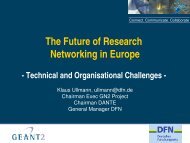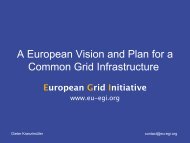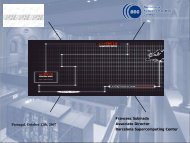e-Infrastructures Roadmap - Internet Society Nederland
e-Infrastructures Roadmap - Internet Society Nederland
e-Infrastructures Roadmap - Internet Society Nederland
- No tags were found...
Create successful ePaper yourself
Turn your PDF publications into a flip-book with our unique Google optimized e-Paper software.
e-<strong>Infrastructures</strong> <strong>Roadmap</strong>Key components of the e-Infrastructure are networking infrastructures, middleware and organisation andvarious types of resources (such as super computers, sensors, data and storage facilities). In diagram 1.1,the relationship between those components becomes clear. The network is at the heart of everything.In the age of hybrid networks, ‘internet’ should probably just read ‘network’ in order to also apply tolambda-networking. The middleware and virtual organisations (exemplified by the black knottedtriangle) connect the distributed resources, data and storage facilities in a seamless way. The applicationdomains (such as e-Science and e-Health) are on the outside of the chart to exemplify the partiesserved by the infrastructure; these are only relevant insofar as they bring in resources.• Middleware and organisationMiddleware plays the intermediary role to facilitate a deep integration of individual componentswith the networks into a European Science Grid. Grids are an evolutionary step in the way we canwork with computers and everything connected to them. A grid consists in principle of a group ofresources (digital devices and anything attached to them or stored on them) which can be used forcombined efforts. The middleware assumes a network such as the internet to run on – or in thecase of GÉANTx a hybrid IP/optical network – and in fact implements a protocol stack into aninteroperable runtime environment and/or query mechanism that allows for sharing of informationand tasks between distributed devices and systems. New processes and procedures have to be devisedto alter the way organisations work, delivering for instance an authentication and authorisationframework. In order to enable the shift from discipline oriented solutions to generic facilitiesspecial attention is needed to support and train users.Let’s take a closer look at each of those components:• Networking Infrastructure1.1 A schematic overview of e-Infrastructure components.The research networking infrastructure delivers the physical connections for the e-Infrastructure.These will primarily be delivered through the hybrid GÉANTx 6 pan-European backbone net-work and the fine-grained National Educational and Research Networks. These networks togetherform the solid basis for the general purpose scientific communication, supporting collaborationand special uses (of which the grid and distributed supercomputing applications are but a few).Europe should continue to play the leading role in building both European-wide and internationalglobal end-to-end connectivity for the Research and Academic community. Additionally, whenlinking to resources that are outside the scientific domain (such as public utility, commercial ormilitary resources) other networks may be added.• Resources (such as supercomputers, sensors, data)The European Science Grid as an integrated approach to serve the European scientific usercommunities should be populated with a number of resources in order for it to add value to theindividual components. The word resources in this context should be interpreted in a broad way,covering literally everything that is of interest to science from computers, large storage facilities,telescopes, satellites, special physics equipment, weather balloons, lasers, spectrometers, visualisationmeans and large sensor networks. A resource can also refer to large data collections, artificialintelligence agents and even people as support organizations that can be shared between institutes.The only requirement is that the resource (from supercomputer to cellphone) can at some pointexchange the necessary information through standardized interfaces, i.e. grid protocols. The endgoal is a rich ecosystem of resources that offer a broad gamma of hardware, software, services anddata spaces.Grid middleware is complemented by other advanced ICT collaboration tools – such as sharingremote work spaces, high resolution videoconferencing. These can be used in their own right, but arealso very relevant to building the community around the grid even though they are generally notbuilt on grid protocols.10 116 Where GÉANTx denotes any future incarnation of the GÉANT/GÉANT2 network.







